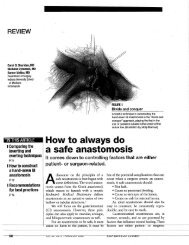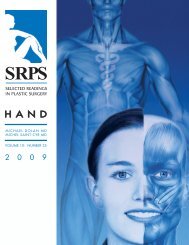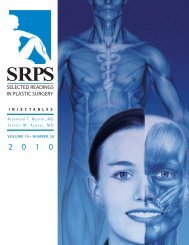Craniofacial Anomalies, Part 2 - Plastic Surgery Internal
Craniofacial Anomalies, Part 2 - Plastic Surgery Internal
Craniofacial Anomalies, Part 2 - Plastic Surgery Internal
Create successful ePaper yourself
Turn your PDF publications into a flip-book with our unique Google optimized e-Paper software.
lengthening was 16.8mm in the mandible and<br />
14.5mm in the midface.<br />
Other complications of craniofacial distraction<br />
osteogenesis are tabulated in Table 8. 521<br />
AUGMENTATION AND CONTOURING PROCEDURES<br />
There are many indications for autogenous bone<br />
grafts in craniofacial surgery. 522 Most craniofacial<br />
surgeons believe that autogenous grafts of bone or<br />
cartilage are the materials of choice in craniofacial<br />
reconstruction because of their resistance to infection<br />
and low morbidity compared with alloplastic<br />
implants. 523 For an in-depth review of the subject,<br />
the reader is referred to Selected Readings in <strong>Plastic</strong><br />
<strong>Surgery</strong> volume 10, number 2. 524<br />
The calvarium is usually the preferred source of<br />
donor autogenous bone for grafting in the craniofacial<br />
skeleton. 79,80,525,526 Cutting 525 delineated the vascular<br />
supply to the cranium and introduced the concept<br />
of using vascularized calvarial bone in craniofa-<br />
TABLE 8<br />
Complication Rates<br />
SRPS Volume 10, Number 17, <strong>Part</strong> 2<br />
cial procedures. He determined that the most<br />
important source of perfusion to the cranium is the<br />
middle meningeal artery, which of course is not useful<br />
as a pedicle for bone transfer. Branches of the<br />
anterior and posterior deep temporal arteries, which<br />
also supply the temporalis muscle, constitute a lesser<br />
vascular supply to the cranium. Finally there is the<br />
vascular plexus fed by the supraorbital, supratrochlear,<br />
superficial temporal, and occipital arteries. The<br />
temporoparietalis fascia (superficial temporal fascia)<br />
contains the superficial temporal artery and provides<br />
a clinically useful pedicle to support a vascularized<br />
calvarial bone graft. 525,527<br />
McCarthy and colleagues 79,80 suggest leaving the<br />
galea and overlying vascular network broadly<br />
attached to the bone when transferring a vascularized<br />
calvarium bone flap because of the poor vascular<br />
connections within the periosteum.<br />
A review of vascularized calvarial inlay grafts based<br />
on a temporalis myoosseous design 528 notes preservation<br />
of the growth potential and a patent suture.<br />
(Reprinted with permission from Mofid MM, Manson PN, Robertson BC, et al: <strong>Craniofacial</strong> distraction osteogenesis: a review of 3278<br />
cases. Plast Reconstr Surg 108:1103, 2001.)<br />
49






